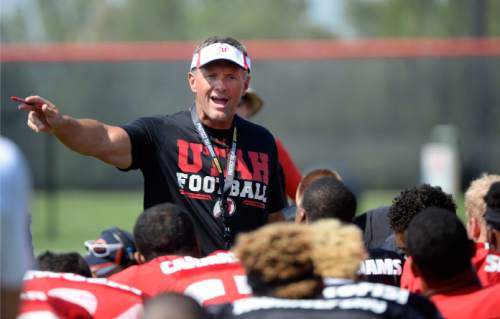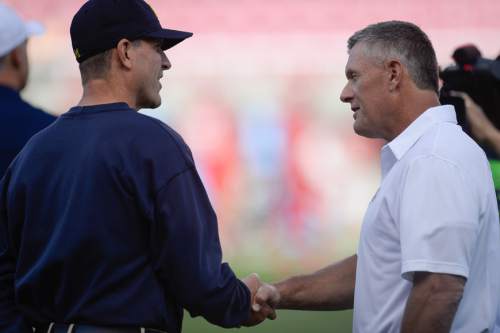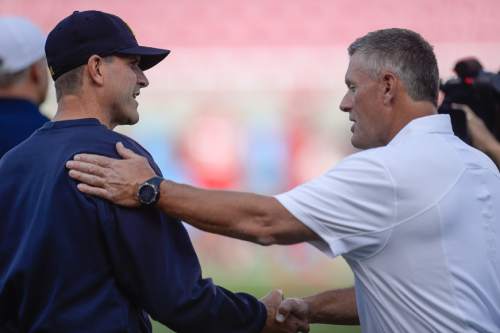This is an archived article that was published on sltrib.com in 2016, and information in the article may be outdated. It is provided only for personal research purposes and may not be reprinted.
Utah football signed three-star linebacker Davir Hamilton in February, but the real work started in 2013.
Before the linebacker and receiver from Long Beach Poly was a three-star recruit, he was an impressionable ninth-grader. That's when he first ran across Utah's staff at a satellite camp in California.
"That's when I really got to know them," Hamilton said in an interview back on Signing Day. "They were really consistent."
Recruiting success stories like Hamilton will be cut off for Utah in the wake of an NCAA decision to end satellite camps.
The NCAA's Division I council ruled on Friday that FBS programs will only be able to hold camps at their facilities regularly used for either practice or competition. http://espn.go.com/college-football/story/_/id/15162704/ncaa-bans-satellite-camps-effective-immediately";>Multiple outlets reported that Power 5 conferences SEC, ACC, Big 12 and Pac-12 were in support of the camp ban, while the Big Ten was against it.
Utah has embraced camps in recent years, http://bit.ly/1d7WI84";>sending staffers to work in four California camps and two Texas camps in June 2015. While the camps have also been used within Utah's borders to against the Utes — notably Oregon State held a satellite camp at Alta High School last year — coach Kyle Whittingham has acknowledged it as an important tool in expanding Utah's recruiting footprint and getting an eye on otherwise inaccessible recruits.
Signee Hamilton and receiver Jamison Field are just two Utes who were first spotted at satellite camps. While Utah doesn't only recruit through camps, it's undoubtedly helped establish them in those states. Of Utah's current roster and signees, 38 players hail from California, and 11 list hometowns in Texas.
Camps are a unique experience: For coaches, it allows them to meet recruits they don't know, and compare others that they've heard of but haven't yet seen. For recruits, it gives a sense of how a coaching staff operates, and gives a feel for what a program's demands will be.
The SEC and ACC already have banned satellite camps more than 50 miles away from campus, so in one sense, the NCAA ruling levels the playing field. But it also makes it tougher for schools in less talent-rich states to recruit in the heavy pipeline states — which for Utah is California, Texas, Florida and Louisiana.
The most vocal opposition to satellite has been the SEC, with several coaches speaking out against Michigan coachhttp://www.detroitnews.com/story/sports/college/university-michigan/wolverines/2016/04/08/ncaa-bans-camp-stops-such-jim-harbaughs/82796060/";> Jim Harbaugh's camps that were spread throughout the South last year. But they have backyards to protect:http://athlonsports.com/college-football/recruiting-analysis-where-do-best-football-players-come";> A 2015 analysis by Athlon Sports revealed that the SEC's 11-state footprint accounted for 559 of the top-rated 1000 recruits on 247 Sports between 2011 and 2015.
In other words: The biggest opponents are closest to the talent. While Utah produces many DI players per capita, there are simply fewer quality recruits, forcing the Utes to reach outside borders.
USA Today's Paul Myerberg also cites another loser: http://www.usatoday.com/story/sports/ncaaf/2016/04/08/ncaa-hurts-players-by-ending-satellite-camps/82796952/";>Under-recruited and under-funded players. If out-of-state athletes want to meet Utah's coaching staff, they now will be forced to pay their own way to come out to Utah's on-campus camp.
Wrote Myerberg: "While it aids the SEC, keeping interlopers out of its recruiting backyard, the new legislation comes at a substantial cost to a wide swath of the FBS — and to the majority of potential student-athletes, many of whom leaned on the access provided by these camps to raise their own recruiting profile."
Like every school affected, Utah will change with NCAA policy.http://bit.ly/20rHT7U";> But coming off its best recruiting class since 2012, the Utes will have to work harder to find the diamond in the rough outside its own backyard.
kgoon@sltrib.com
Twitter: @kylegoon







